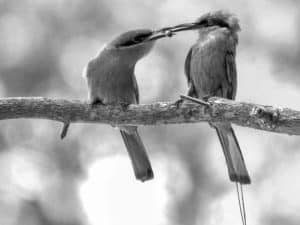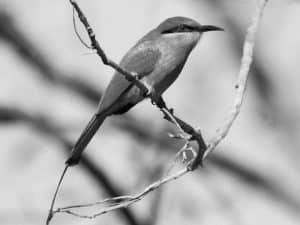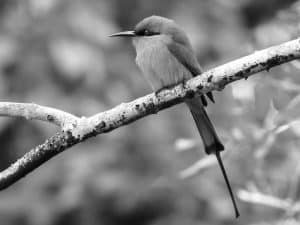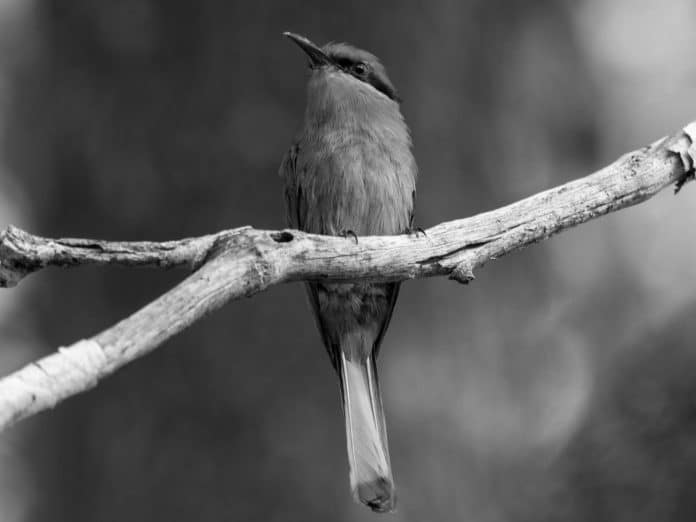Introduction to the Böhm’s Bee-Eater
Welcome to the enchanting world of the Böhm’s Bee-Eater, a stunning bird that graces the woodlands of Tanzania with its vibrant colors and graceful flight. The Böhm’s Bee-Eater, scientifically known as Merops boehmi, is a member of the bee-eater family, and it is a sight to behold with its striking plumage and aerial acrobatics. This beautiful bird is a testament to the natural wonders found in Tanzania and has captured the hearts of birdwatchers and nature enthusiasts from around the world. In this article, we will delve into the habitat, distribution, characteristics, behavior, conservation status, and the best locations for birdwatching this captivating species in Tanzania.
Habitat and Distribution of Böhm’s Bee-Eater in Tanzania

The Böhm’s Bee-Eater is a migratory bird that can be found in the woodlands, savannas, and riverine habitats of Tanzania. These birds prefer open country with scattered trees, making the woodlands of Tanzania an ideal environment for them. They are known to breed in the region and can be found in various parts of the country, including the Serengeti, Tarangire, and Selous. The abundance of insect life in these areas provides the perfect hunting grounds for the Böhm’s Bee-Eater, allowing them to thrive and display their breathtaking colors amidst the lush greenery of the Tanzanian woodlands.
The distribution of the Böhm’s Bee-Eater in Tanzania is influenced by the availability of suitable nesting sites and food sources. These birds are known to form colonies for breeding, often excavating tunnels in sandy banks to create their nests. The diverse landscapes of Tanzania provide the Böhm’s Bee-Eater with the nesting opportunities they require, and their presence adds to the ecological richness of the region.
Characteristics and Behavior of Böhm’s Bee-Eater
The Böhm’s Bee-Eater is renowned for its striking appearance, characterized by a combination of vibrant colors that make it a standout species in the avian world. The upperparts of the bird are adorned with a rich chestnut hue, while the throat and breast display a beautiful blend of blue and green feathers. Its distinctive tail feathers add to its allure, making it a visual feast for birdwatchers and photographers alike.
In addition to its captivating appearance, the Böhm’s Bee-Eater is known for its remarkable aerial displays as it hunts for flying insects. With agile and swift flight, these birds skillfully capture their prey, often returning to a perch to deliver a swift and precise blow to immobilize their catch before consuming it. Their acrobatic foraging behavior and vibrant colors make the Böhm’s Bee-Eater a true spectacle in the Tanzanian woodlands, captivating all who have the privilege of witnessing their graceful movements.
Conservation Status and Efforts in Tanzania
Despite the natural beauty and ecological significance of the Böhm’s Bee-Eater, its population faces threats due to habitat loss and degradation. The conservation status of the Böhm’s Bee-Eater in Tanzania is a cause for concern, and efforts are being made to protect and preserve their habitats. Conservation organizations and local authorities are working together to address the challenges faced by this species, implementing measures to safeguard their nesting sites and foraging grounds.
The establishment of protected areas and wildlife corridors in Tanzania plays a crucial role in the conservation of the Böhm’s Bee-Eater and other avian species. These initiatives aim to maintain the integrity of the woodlands and ensure the continued presence of these magnificent birds in their natural environment. Through community engagement and conservation education, efforts are being made to raise awareness about the importance of preserving the habitats that are vital to the survival of the Böhm’s Bee-Eater, contributing to the overall conservation of Tanzania’s rich biodiversity.
Best Locations for Birdwatching Böhm’s Bee-Eater in Tanzania
For birdwatchers and nature enthusiasts seeking to catch a glimpse of the Böhm’s Bee-Eater in its natural habitat, Tanzania offers a variety of prime locations for an unforgettable birdwatching experience. The Serengeti National Park, renowned for its iconic wildlife and vast grasslands, is also home to the Böhm’s Bee-Eater during the breeding season. The woodlands and riverine areas within the park provide ideal opportunities to observe these birds in their natural environment, against the backdrop of the park’s diverse landscapes.
Another notable location for birdwatching the Böhm’s Bee-Eater is the Tarangire National Park, where the bird’s vibrant colors stand out amidst the ancient baobab trees and lush vegetation. The park’s diverse habitats and abundant insect life make it a favored destination for these magnificent birds, offering birdwatchers the chance to witness their aerial feats and vibrant plumage up close. Additionally, the Selous Game Reserve, with its expansive woodlands and river systems, provides ample opportunities for spotting the Böhm’s Bee-Eater in its natural habitat, adding to the allure of birdwatching in Tanzania.
Tips for Birdwatching and Photographing Böhm’s Bee-Eater

When embarking on a birdwatching excursion to observe the Böhm’s Bee-Eater in Tanzania, there are several tips that can enhance the experience and increase the chances of encountering these captivating birds. Patience is key when birdwatching, as the Böhm’s Bee-Eater’s aerial displays may require time and observation to fully appreciate. By quietly observing their behavior and movements, birdwatchers can gain a deeper understanding of the bird’s foraging techniques and interactions within their natural environment.
Photographing the Böhm’s Bee-Eater presents a unique opportunity to capture the vibrant colors and graceful flight of these birds. For aspiring wildlife photographers, it is essential to be equipped with the appropriate camera gear and to practice fieldcraft techniques to approach the birds without causing disturbance. By respecting the natural behavior of the Böhm’s Bee-Eater and maintaining a respectful distance, photographers can capture stunning images that showcase the bird’s beauty against the backdrop of the Tanzanian woodlands.
Other Bird Species Found in Tanzanian Woodlands
While the Böhm’s Bee-Eater is a star attraction in the Tanzanian woodlands, the region is also home to a diverse array of bird species that contribute to its rich avian biodiversity. The woodlands of Tanzania provide habitat for an impressive variety of birds, including raptors, hornbills, barbets, and numerous other species with unique plumage and vocalizations. The Rufous-crowned Roller, Lilac-breasted Roller, and Grey-headed Kingfisher are among the many avian treasures that can be encountered while exploring the woodlands of Tanzania.
In addition to resident bird species, Tanzania serves as a vital stopover and wintering ground for migratory birds, further enriching the avian diversity of the region. The woodlands and wetlands of Tanzania provide essential habitats for these migratory birds, offering rewarding opportunities for birdwatchers to observe a wide range of species throughout the year. The coexistence of resident and migratory birds in the Tanzanian woodlands contributes to the dynamic and vibrant birdlife that awaits exploration by enthusiasts and researchers alike.
Ecotourism and Birdwatching Tours in Tanzania
The allure of Tanzania’s woodlands and the captivating birdlife they harbor have contributed to the growth of ecotourism and birdwatching tours in the region. Visitors from around the world are drawn to the natural beauty and ecological richness of Tanzania, seeking opportunities to immerse themselves in the diverse landscapes and wildlife experiences the country has to offer. Ecotourism initiatives and birdwatching tours provide avenues for travelers to engage with the natural environment, while also supporting conservation efforts and local communities.
Participating in birdwatching tours in Tanzania offers enthusiasts the chance to explore various habitats and encounter a wide array of bird species, including the mesmerizing Böhm’s Bee-Eater. These tours are often guided by experienced naturalists and birding experts who possess in-depth knowledge of the region’s avian diversity and can provide valuable insights into the behavior and ecology of the birds. By engaging in responsible and sustainable ecotourism practices, visitors can contribute to the preservation of Tanzania’s woodlands and the conservation of its avian inhabitants.
Böhm’s Bee-Eater Research and Studies in Tanzania

Scientific research and studies focused on the Böhm’s Bee-Eater are instrumental in expanding our understanding of this species and its ecological significance within the Tanzanian woodlands. Researchers and conservationists conduct field studies to gather data on the behavior, breeding biology, and population dynamics of the Böhm’s Bee-Eater, contributing to conservation initiatives and the formulation of management strategies to protect the species and its habitats.
Collaborative efforts between local research institutions, conservation organizations, and international partners support ongoing studies aimed at monitoring the distribution and abundance of the Böhm’s Bee-Eater in Tanzania. By employing techniques such as bird banding, nest monitoring, and ecological surveys, researchers are able to track the movements and population trends of the Böhm’s Bee-Eater, providing valuable insights for its conservation and management. Furthermore, research findings contribute to educational outreach programs and conservation advocacy, raising awareness about the importance of preserving the woodlands that are vital to the survival of the Böhm’s Bee-Eater and other avian species in Tanzania.
Conclusion
In conclusion, the Böhm’s Bee-Eater stands as a symbol of the natural wonders found in the woodlands of Tanzania, captivating observers with its breathtaking colors and aerial prowess. The habitat, distribution, characteristics, behavior, and conservation status of the Böhm’s Bee-Eater underscore its ecological significance and the efforts dedicated to its preservation. As part of the diverse avian community in Tanzania, the Böhm’s Bee-Eater contributes to the rich tapestry of birdlife found in the woodlands, offering a compelling reason for birdwatchers, researchers, and ecotourists to explore and appreciate the ecological splendor of the region.
Whether witnessed in flight against the backdrop of the Tanzanian woodlands or studied through dedicated research and conservation efforts, the Böhm’s Bee-Eater embodies the allure and importance of avian biodiversity in the natural world. By embracing responsible ecotourism practices, supporting conservation initiatives, and promoting scientific research, we can play a role in safeguarding the habitats and species that make Tanzania a haven for birdwatching and ecological discovery.

































